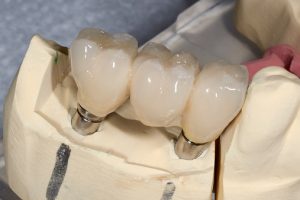Getting Dental Bridges
Learn what getting a dental bridge involves and the pros and cons of this type of restoration.

What is a Dental Bridge?
A dental bridge is a type of prosthetic consisting of three or four crowns bonded together in a row. The middle crown or crowns replace your missing tooth or teeth. The end crowns go over the teeth to either side of the gap to anchor your replacement teeth in place.
What Is Involved in Getting Dental Bridges?
Getting a dental bridge typically involves the following steps:
Prepping the anchor teeth: The teeth that will anchor the bridge need to be strong and healthy, so sometimes it is necessary to do a root canal or other treatment on them as a first step towards getting a bridge. The anchor teeth will always need to be filed down in order to allow the crowns to fit over them.
Taking an impression: In order to create a bridge that looks natural and fits well, we need to take detailed measurements of your mouth. This can be done using traditional rubber putty impressions, or with a digital scanner. At California Dental Group we use the iTero scanner to take detailed measurements quickly and comfortably.
Making the bridge: The next step is to order the bridge from the dental lab. With the latest in computer-aided technology, ceramic bridges can be made very quickly and to a high quality standard.
Placing the bridge: If computer-aided technology is used, the bridge should be ready to be permanently placed on the same day it was ordered. Otherwise, you will need to get a temporary bridge placed and come back in a few days for the permanent bridge.
What are the Pros and Cons of Dental Bridges?
Dental bridges offer an affordable and relatively non-invasive way to replace missing teeth. There is no need for surgery and the healing time is much faster than you would see with dental implants. However, dental bridges do not last forever. They are vulnerable to any decay that may occur on the teeth anchoring the bridge. Additionally, it is possible for bits of food and bacteria to get trapped under the bridge, which can cause gum disease and further weaken the restoration.
Want to Learn More?
If you want to learn more about using dental bridges to replace missing teeth, please contact California Dental Group and make an appointment with one of our caring dentists.




